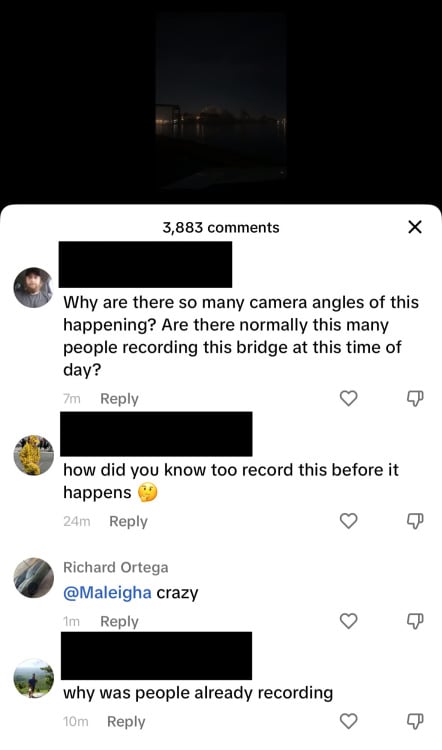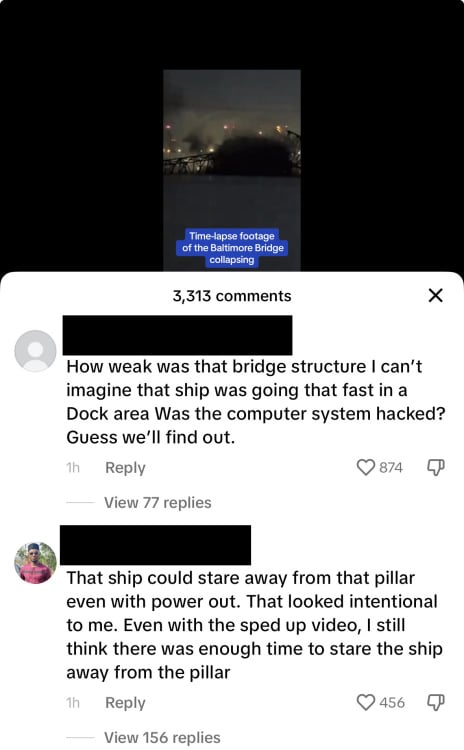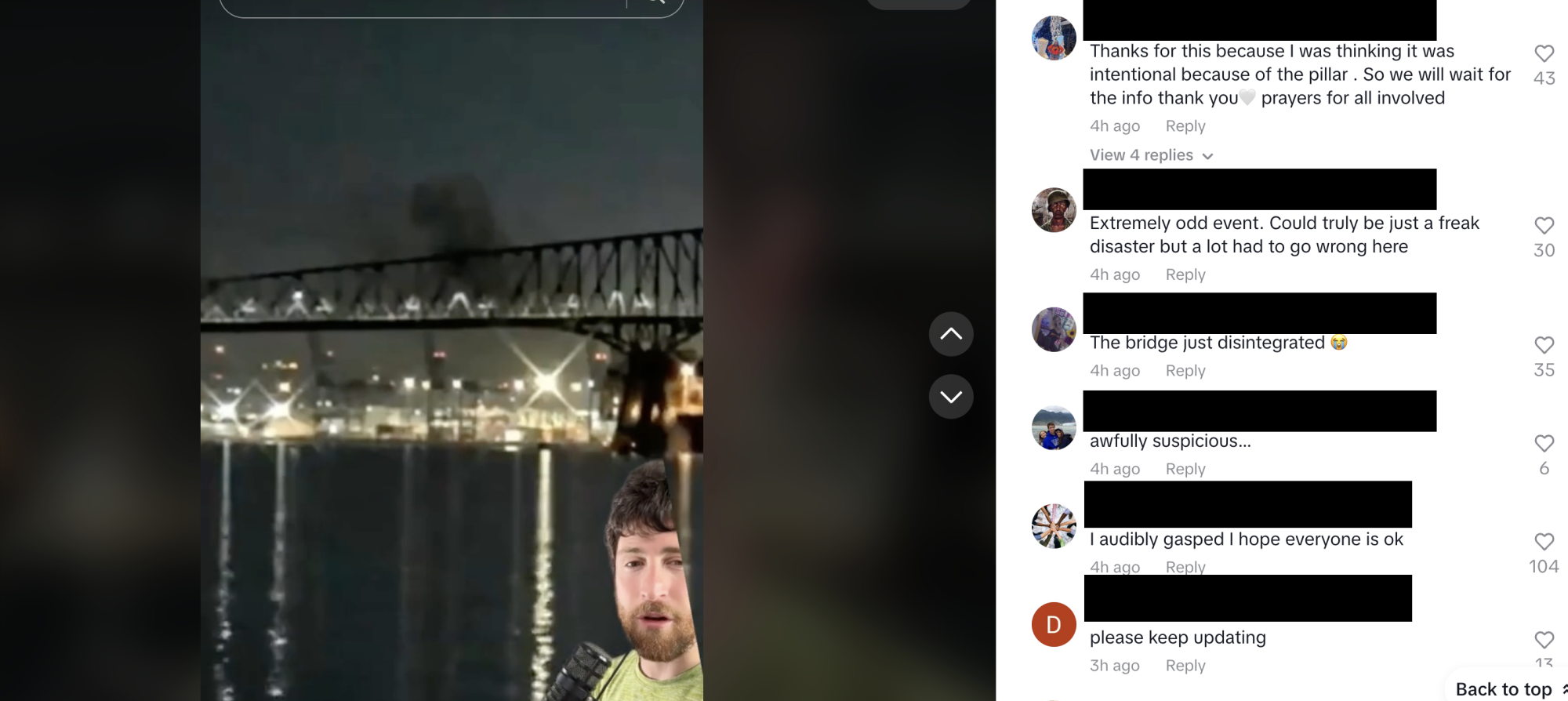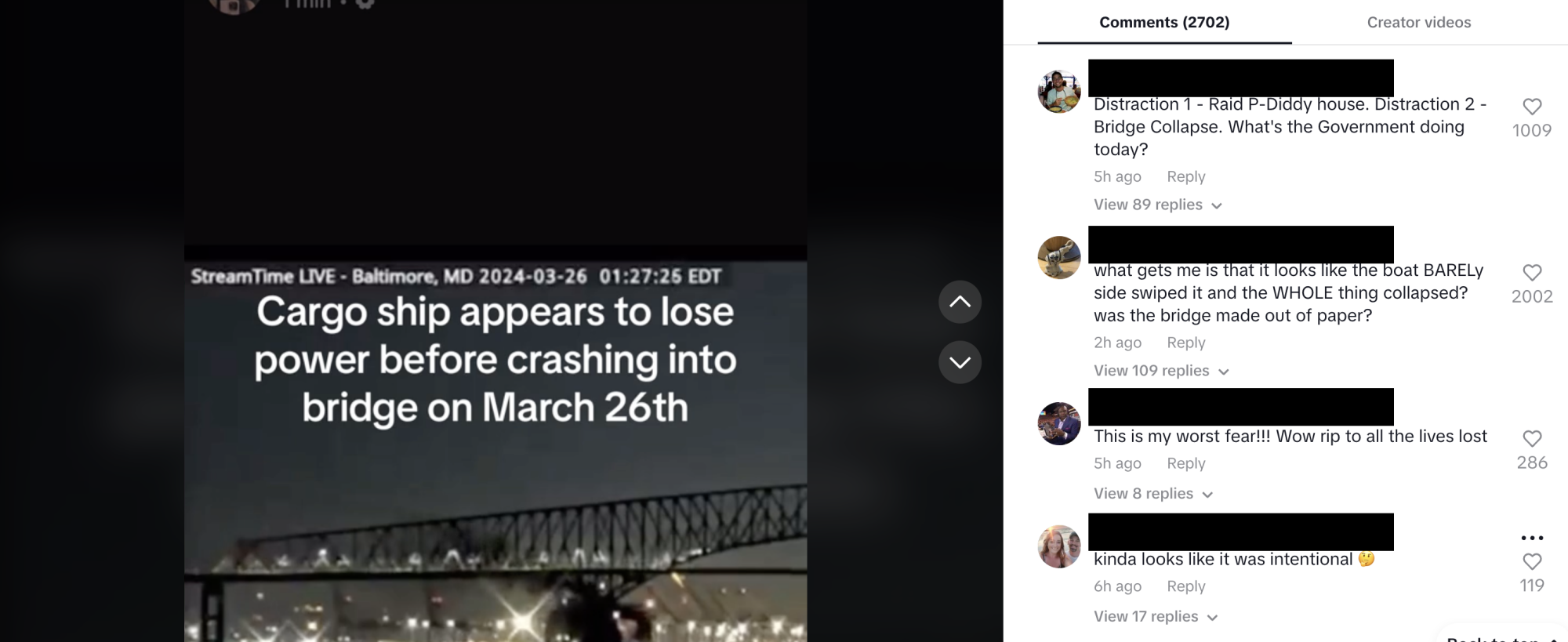Baltimore’s Key Bridge collapse put the internet’s conspiracy brain on gross display
In the early hours Tuesday, in Baltimore, Maryland, a massive cargo ship rammed into the Francis Scott Key Bridge. The bridge collapsed shortly thereafter, reportedly plunging eight people into the waters below, six of whom are still missing.
It is a horrific tragedy. It was also caught on live cams and seemingly filmed by nearby witnesses. The footage is bone-chilling.
Yet, nearly immediately, this horrible incident was met with conspiracy theories and people just asking questions despite a complete and total lack of evidence suggesting this was anything but a tragic accident. It puts into stark relief just how broken the internet’s collective brain is, and, relatedly, just how much being online has steered folks toward conspiratorial, nonsensical thinking. To a certain subset of people, it appears, nothing can be as it seems — there has to be a nefarious or salacious backbone to any story, no matter how obviously tragic.
Here’s a disturbing and sad thought. A couple hours after most of the East Coast woke up — and some eight hours after the accident itself — and the conspiracies are already too numerous to fully count. The octopus’ tentacles have already spread. That’s the way these things go. Folks latch onto one piece of “info” here, another “thought” there, and the conspiracies get confusing and nearly impossible to comprehend. Think of how something like QAnon bleeds into Epstein conspiracies which fuses with political conspiracies, and forever and ever it goes on.
But soon after the bridge collapse, one popular theory popped up prominently in the comment sections of TikTok videos of the accident. There were lots of just asking questions about how there were so many angles of the collapse. People wondered how witnesses would just know to film at that exact time. Seriously, this type of comment was posted quite a lot on disturbing video footage. How is that peoples’ first thought?

Credit: Screenshot: TikTok / @toby_jg02

Credit: Screenshot: TikTok / @toby_jg02
Let’s take a step back and be logical here. Why would there be so many videos? First, the Key Bridge spanned the Baltimore Harbor, which is a major port. There are live cams on the bridge and harbor. Many of the videos seemed to come from those cameras. Also, if you happened to be in the area and awake shortly before 2 a.m. — Baltimore is a densely populated city with people out at all times — you might begin filming when you heard the likely horrific and loud sound of a cargo ship ramming into a bridge. The fact that there are multiple angles of the accident is far from surprising. It’s 2024. It’s expected, at least if you stop to think about it for a moment. Also, not for nothing, but if some shadowy group or entity was going to do something as horrific as this why would they want to have it filmed? As a famous Baltimore-based show pointed out — “is you taking notes on a criminal conspiracy?” — someone wouldn’t purposefully create evidence to incriminate themselves.
But that’s where the internet is. If anything happens online — and, well, everything happens online — there are bound to be theories about how things are not as they seem. Think of the recent Kate Middleton debacle, which obviously inspired more mainstream and prevalent conspiracies. Middleton had been diagnosed with cancer and was dealing with it privately, but the online ecosystem wouldn’t allow for that vacuum of information. Mashable’s Meera Navlakha summarized the emergence of the royal Photoshop chaos and early spin, and Ryan Broderick, who writes the digital culture newsletter Garbage Day, did a good job breaking down how the Middleton theories expanded and got out of control.
Broderick wrote, near the conclusion of the piece:
“Over the last 25 years we have slowly uploaded every part of our lives to a system of platforms run by algorithms that make money off our worst impulses. Well, the ones brands are comfortable advertising around. And for years we have wondered what the world might look like when we crossed the threshold into a fully online world. Well, we did. We crossed it. This is what it looks like.”
The Rubicon is well in the rear-view and it means even a tragic bridge collapse or cancer diagnosis is subjected to the often mis-aligned spotlight of the internet’s conspirators.
And, by the way, the how were there cameras is far from the only theory and “question” to arise in the hours after the collapse. Conspiracists questioned if DEI were to blame, or Jewish people, or unnamed terrorists. Lots of people wondered how the bridge could collapse just because it was hit, not taking into account, of course, just how massive that a cargo ship really is.
People suggested in the comments that it could’ve been intentional or some kind of “distraction” planted by the government.

Credit: Screenshot: TikTok / @dailymail

Credit: Screenshot: TikTok / @joeycontino2

Credit: Screenshot: TikTok / @apaynelife757
Fox News host Maria Bartiromo, on air, went right from talking about the White House saying there was no evidence of nefarious intent to talking about the “wide open border” in a now-viral clip.
This is where we are now. A tragedy is, almost immediately, grist for the internet’s mill. You could see the theories shape-shift and grow in real time on Tuesday. The internet has, almost subliminally, taught folks that they can tie a hobbyhorse gripe to any major incident.
To be clear: This is not everyone. Far from it. And that’s not to say skepticism isn’t warranted online. Especially amid the rise of AI, it’s worth stopping for a second to consider what is real and what isn’t. It’s worth questioning power and the official story. But the internet’s predilection for conspiratorial thinking, depressingly, sucks the oxygen out of other, real issues that might be worth questioning. Maybe we should be talking about the degradation of America’s infrastructure. But maybe not through the lens of how this accident can be pinned on someone or some thing.
Conspiracy theories, just asking questions, all of this isn’t new. We’ve seen it time and again. The worst things imaginable — Sandy Hook, notably — have all been subjected to it.
But Tuesday morning made clear how impossible it is to escape. How engrained it now is in our culture. Our internet brains, the internet’s brain, it’s all one and the same.
Around 1:30 a.m. Tuesday the Key Bridge collapsed in what all indications suggest was a horrible accident. And before most of Baltimore had gotten out of bed, the internet was already questioning the city’s awful reality.


